
Blueberry U-Pick Orchards in Berkshire, Bucks and Oxfordshire in 2025, by county
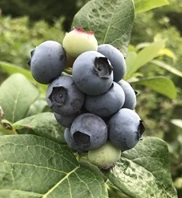 Below are the PYO orchards and farms for blueberries that we know of in this area. Not all areas have blueberries orchards or farms that are open to the public. If you know of any others, please tell us using the add a farm form!
Below are the PYO orchards and farms for blueberries that we know of in this area. Not all areas have blueberries orchards or farms that are open to the public. If you know of any others, please tell us using the add a farm form!
Remember to always check with the farm's own website or Facebook page before you go - or call or email them if they don't have a website or Facebook page. Conditions at the farms and crops can change literally overnight, so if you want to avoid a wasted trip out there - check with the farm directly before you go! If I cannot reach them, I DON'T GO!
PLEASE report closed farms, broken links and incorrect info using the "Report Corrections" form below.
Berkshire
Buckinghamshire (Bucks)
-
Peterley Manor Farm - PYO Apples, plums, cherries,
blackberries, red and blackcurrants, raspberries, strawberries, Tayberries,
gooseberries, beetroot, broad beans, French beans, mange-tout, peas, runner
beans, spinach
Peterley Lane, Prestwood, Great Missenden. Phone: 01494 863566. Email: hello@peterleymanorfarm.co.uk. Open: Click here for our harvest calendar. Directions: A4128 High Wycombe/Grt Missenden Road; turn right before Prestwood signed Little Missenden/Amersham. Family run farm shop & PYO. Xmas trees grown on the farm. The farm shop has orchard fruits, soft fruits, vegetables, free range eggs, preserves, honey, pure fruit juices. Facilities: Ample parking, picnic area, plants and shrubs for sale. Our location in the commuter belt and close proximity to Great Missenden train station, sees even Londoners venturing out at the weekend for a taste of the countryside. We began with strawberries, raspberries and broad beans and have gradually added to the range available to now include gooseberries, currants and tree fruits including plums and apples; vegetables such as runner beans, peas, beetroot and carrots, and the most recent additions include blueberries and cobnuts. Traditional methods of farming are still used including organic fertilisers and hand planting. The Pick Your Own starts in mid June with strawberries and gooseberries and runs right through to the end of October with autumn raspberries and various vegetables. Please see our seasonal calendar for information about specific crop availability. Pick Your Own was the original feature of the farm and we now grow over 20 acres of crops specifically for PYO, ranging from strawberries, raspberries and gooseberries to plums and blueberries. Here are the typical dates of availability (always call or see our website first) Click here for a link to our Facebook page.
Apples in September
Blackberries in July
Blackcurrants in June - July
Broad Beans in July
Gooseberries in June - August
Plums in July - August
Raspberries in July
Redcurrants in June - July
Strawberries in June - August
(UPDATED: 20 October 2020 JBS)
Oxfordshire
Blueberry Picking Tips, Recipes and Information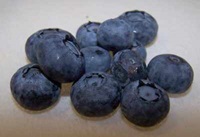
Blueberries are one of the easiest fruit to prepare and serve. There's no peeling, pitting, coring or cutting. They have few natural pests, (other than birds), so pesticides are generally unnecessary! This year's crop is fantastic (see related news story), thanks both to the weather and to more farms planting more blueberry bushes due to increased consumer demand over the past few years as more studies proclaim the anti-oxidant and other health properties of blueberries.
Click here to find a local Blueberry Festival (usually held between April and July).
If you are looking for information about a similar
berry, the saskatoon (also called the June berry or Serviceberry)
see this page about
saskatoons.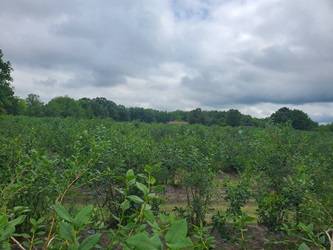
Picking tips:
Select plump, full blueberries with a light gray-blue color. A berry with any hint of red isn't fully ripened.
Ripening AFTER picking?
First, it is key to know that once picked, blueberries will NOT become any sweeter, nor will the flavor improve. The only change that occurs is the color. They will APPEAR to ripen, but it is only a color change, from white to green to rose to red to pale blue to fully blue. So, white and green colored blueberries will not "ripen" after they are picked; while blueberries that have already turned purple, red or blue-ish usually DO change color after they are picked (if they are kept at room temperature to "ripen").
As the blueberries ripen ON THE BUSH, the flavor goes from tastless to bitter to tasteless tart to tart blueberry flavor to sweet blueberry flavor.
Grocery stores sell blueberries that are tart, not sweet because they had them picked unripe by machine so they are very firm and can handled being bumped around in shipping. They may look good, but are not as tasty as those picked when actually ripe.

So, the key is, PICK ONLY RIPE BERRIES!
How to pick blueberries
Since blueberries hang on the bushes in bunches a but like grapes do, the easiest and fastest way to pick them is hold your bucket under them in one hand and with your other hand, cup a ripe bunch and gently rub them with your fingers. The ripe berries will drop into your bucket, while the unripe ones will remain attached to the bush.
When the bushes are at peak, I can easily pick 2 gallons per hour (if I'm not being distracted by the kids and the sun isn't too hot!). A newbie might do 1 gallon per hour.and at the beginning or end of the season it takes more time as the berries are not as plentiful nor concentrated in clusters.
Tips for storing blueberries after harvesting:
- Once picked, don't place the berries, still warm from the sun, in a closed bag or container. Leave the container open so moisture doesn't form in the container.
- Don't wash berries until just before using, to prevent berries from becoming mushy.
- Chill berries soon after picking to increase shelf life. Store your fresh blueberries in the refrigerator as soon as you get them home, without washing them, in a covered bowl or storage container. If refrigerated, fresh-picked blueberries will keep 10 to 14 days.
- Freeze berries in freezer containers without washing to keep the skins from toughening. Place berries one layer deep. Freeze, then pour the frozen berries into freezer containers. Because unwashed blueberries freeze individually, they can be easily poured from containers in desired amounts. Remember both frozen and fresh berries should be rinsed and drained just before serving. Just before using, wash the berries in cold water.
Blueberry Measurements and Conversions
Keep in mind that blueberries vary considerably in density and moisture content, so these ranges are approximates.
-
1 gallon of blueberries weighs about 7.5 lbs or (4 liters of blueberries is about 3.5 kg)
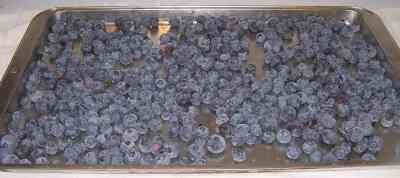
-
1 pint of fresh blueberries weights about 3/4 of a pound. (1 liter of blueberries is about 700 grams)
-
1 pound of fresh blueberries is usually between about 2 and 3 cups of berries.
-
It takes about 4 cups (about of blueberries to make a blueberry pie (see this fantastic and easy blueberry pie recipe)
-
A normal batch of blueberry preserves, jam or jelly requires 5 pints of berries.
-
Blueberries do come in a variety of sizes from small (190-250 berries per cup) to extra large (<90 berries per cup).
Blueberry Recipes, Canning and Freezing Blueberries
Recipes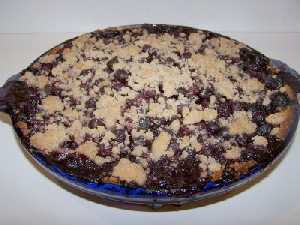
- The world's best Blueberry pie, recipe and directions and illustrated!
- Blueberry buckle coffee cake: illustrated directions for this great crumb-topping blueberry coffee cake
- Other easy directions to make blueberry desserts: cobblers, etc.
Canning, freezing and other blueberry recipes:
- How to Freeze Blueberries
- How to Can Blueberries
- How to Make Homemade Blueberry Jam
- How to make blueberry jelly
- How to make and can blueberry syrup (it works for strawberries, raspberries and blackberries, too)
- blueberry pie filling to use later,
- blueberry butter
Baking tips
If you have trouble with blueberries settling to the bottom of muffins and blueberry breads, try one or more of these tips:
- Coat them with flour before adding to the batter. Just gently shake the blueberries in a bag (plastic or paper) with 1/2 cup of flour, then dump them mix in a sieve to remove excess flour.
- It may just be that your batter is too thin. try making the batter a little thicker!
- Fill the muffin cups or baking pan up to 1/4 full with batter (which hasn't had blueberries added to it yet); then stir the blueberries into the remaining batter, and continue to fill the muffin cups or bread pan. The blueberries will start off higher in the mix!